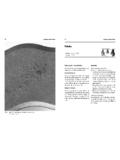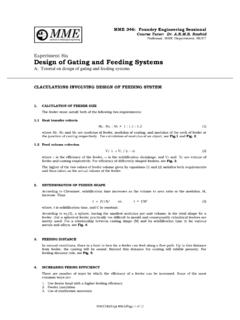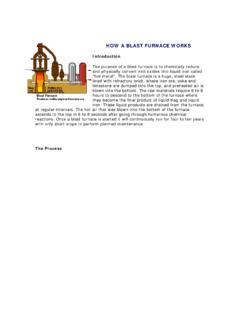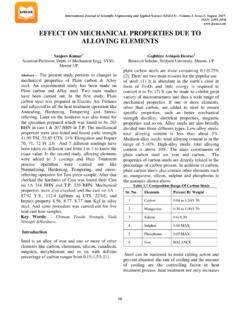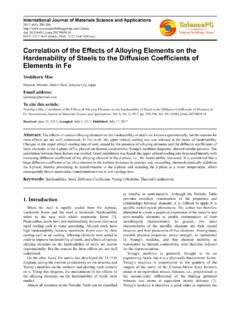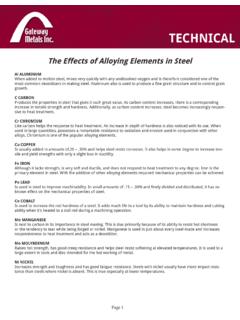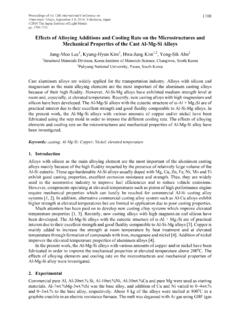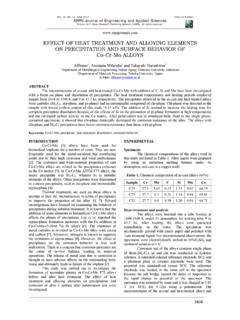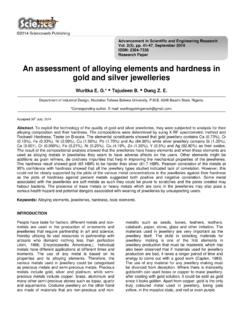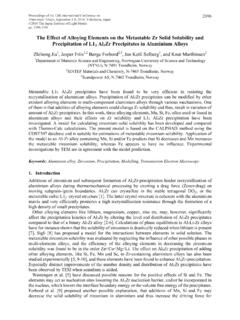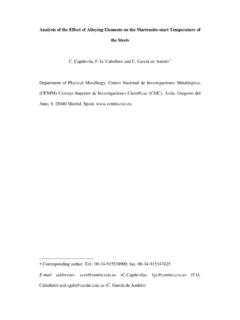Transcription of Effects of Alloying Elements - Aluminum Alloys
1 14/12/2016 Effects of Alloying Elements Aluminum Alloys | Mike M. | Pulse | Alloying Elements Aluminum Alloys mike m 1/7alloying element ,Cast houseEffects of Alloying Elements - AluminumAlloysPublished on November 30, 2016 Antimony is present in trace amounts ( to ppm) primary in commercial gradealuminum. Antimony has a very small solid solubility in Aluminum (< ). Somebearing Alloys contain up to 4 to 6% Sb. Antimony can be used instead of bismuth tocounteract hot cracking in Aluminum magnesium The compound AsAl is a semiconductor.
2 Arsenic is very toxic (as AsO3) andmust be controlled to very low limits where Aluminum is used as foil for is used in Aluminum Alloys containing magnesium to reduce oxidation atelevated temperatures. Up to Be is used in aluminizing baths for steel to improveadhesion of the Aluminum film and restrict the formation of the deleterious iron Aluminum The low melting point metals such as bismuth, lead, tin, and cadmium areadded to Aluminum to make free machining Alloys . These Elements have a restrictedsolubility in solid Aluminum and form a soft, low melting phase that promotes chipMike Manager ( Alloying tablet, master alloy)- HARBIN NetworkLearningJobsInterestsBusiness ServicesTry Premium for free Advanced Search for people, jobs, companies, and 6 2 114/12/2016 Effects of Alloying Elements Aluminum Alloys | Mike M.
3 | Pulse | Alloying Elements Aluminum Alloys mike m 2/7breaking and helps to lubricate the cutting tool. An advantage of bismuth is that itsexpansion on solidification compensates for the shrinkage of lead. A 1 to 1 lead bismuth ratio is used in the Aluminum copper alloy, 2011, and in the Aluminum Mg Sialloy, 6262. Small additions of bismuth (20 to 200 ppm) can be added to Aluminum magnesium Alloys to counteract the detrimental effect of sodium on hot is used in Aluminum and its Alloys as a grain refiner and to improve conductivityby precipitating vanadium, titanium, chromium, and molybdenum.
4 Boron can be usedalone (at levels of to ) as a grain refiner during solidification, but becomesmore effective when used with an excess of titanium. Commercial grain refinerscommonly contain titanium and boron in a 5 to l is a relatively low melting element that finds limited use in Aluminum . Up Cd may be added to Aluminum copper Alloys to accelerate the rate of agehardening, increase strength, and increase corrosion resistance. At levels of , it has been used to reduce the time of aging of Aluminum zinc magnesium has very low solubility in Aluminum and forms the intermetallic CaAl4.
5 Aninteresting group of Alloys containing about 5% Ca and 5% Znhave superplasticproperties. Calcium combines with silicon to form CaSi2, which is almost insoluble inaluminum and therefore will increase the conductivity of commercial grade metalslightly. In Aluminum magnesium silicon Alloys , calcium will decrease age effect on Aluminum silicon Alloys is to increase strength and decrease elongation, butit does not make these Alloys heat may occur infrequently as an addition in Aluminum in the form of oxycarbidesand carbides, of which the most common is A14C3, but carbide formation with otherimpurities such as titanium is possible.
6 A14C3decomposes in the presence of water andwater vapor, and this may lead to surface , mostly in the form of mischmetal (rare earths with 50 to 60% Ce), has beenadded experimentally to casting Alloys to increase fluidity and reduce die occurs as a minorimpurity in commercial purityaluminum (5 to 50 ppm). It has alarge effect on electricalresistivity. Chromium is acommon addition to many alloysof the Aluminum magnesium, Aluminum magnesium silicon,and Aluminum magnesium zincgroups, in which it is added inamounts generally not exceeding In excess of these limits, it tends to form verycoarse constituents with other impurities or additions such as manganese, iron, andtitanium.
7 Chromium has a slow diffusion rate and forms fine dispersed phases inwrought products. These dispersed phases inhibit nucleation and grain is used to control grain structure, to prevent grain growth in Aluminum HomeProfileMy NetworkLearningJobsInterestsBusiness ServicesTry Premium for free Advanced Search for people, jobs, companies, and 6 2 1 HomeProfileMy NetworkLearningJobsInterestsBusiness ServicesTry Premium for free Advanced Search for people, jobs, companies, and 6 2 114/12/2016 Effects of Alloying Elements Aluminum Alloys | Mike M.
8 | Pulse | Alloying Elements Aluminum Alloys mike m 3/7magnesium Alloys , and to prevent recrystallization in Aluminum magnesium silicon oraluminum magnesium zinc Alloys during hot working or heat is not a common addition to Aluminum Alloys . It has been added to somealuminum silicon Alloys containing iron, where it transforms the acicular ( Aluminum iron silicon) into a more rounded Aluminum cobalt iron phase, thus improving strengthand elongation. Aluminum zinc magnesium copper Alloys containing Co are produced by powder Aluminum copper Alloys containing 2 to 10% Cu, generally with otheradditions, form important families of Alloys .
9 Both cast and wrought Aluminum copperalloys respond to solution heat treatment and subsequent aging with an increase instrength and hardness and a decrease in elongation. The strengthening is maximumbetween 4 and 6%Cu, depending upon the influence of other constituents magnesium. The main benefit of adding magnesium to Aluminum copperalloys is the increased strength possible following solution heat treatment andquenching. In wrought material of certain Alloys of this type, an increase in strengthaccompanied by high ductility occurs on aging at room temperature.
10 On artificial aging,a further increase in strength, especially in yield strength can be obtained, but at asubstantial sacrifice in tensile magnesium plus other Elements . The cast Aluminum copper magnesiumalloys containing iron are characterized by dimensional stability and improved bearingcharacteristics, as well as by high strength and hardness at elevated , in a wrought Al 4%Cu alloy, iron in concentrations as low as the tensile properties in the heat treated condition, if the silicon content is lessthan that required to tie up the iron as the aFeSi is an addition in Aluminum and is usually present at levels of to these levels its effect on mechanical properties is quite small.
